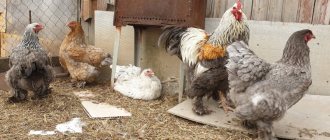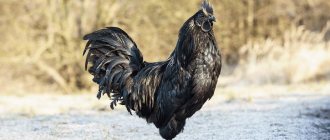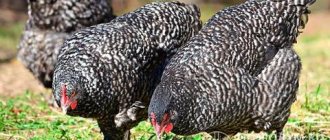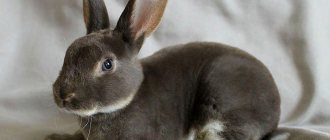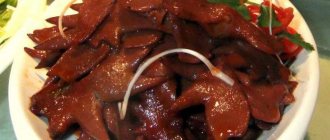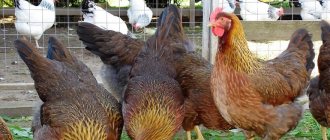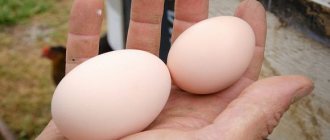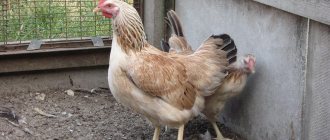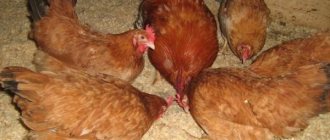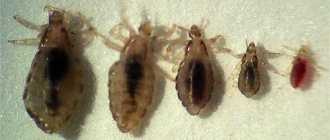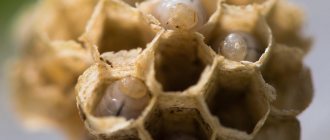Dwarf chickens became popular about 200 years ago. They differ from ordinary domestic layers not only in their small size, but also in the more delicate structure of the meat fibers and attractive appearance. The main advantages of miniature birds are their low food consumption and the absence of the need to allocate a lot of space for their maintenance.
Dwarf rooster
Features of dwarf breeds
The main feature of dwarf chickens is their size and body weight. But despite the fact that the bird’s weight ranges from half to one and a half kilograms, chickens are capable of producing fairly large eggs (up to fifty grams) with an egg production of over one hundred to two hundred eggs per year. The meat of dwarf birds also has excellent taste, and the daily food requirement is much less than that of ordinary varieties.
Dwarf chickens may be small, but in most cases they have good productive qualities.
Meanwhile, it is worth noting another side of dwarf breeds - their whimsical care. Most species love warmth and do not tolerate dampness. Therefore, when growing, do not forget about heating the chicken coop in winter.
Dwarf chickens often participate in exhibitions. For this to be possible, it is important to correctly select young animals during purchase and breeding so that they meet all recommended breed standards.
Common Breeds
Currently, many different dwarf breeds have been bred, including decorative ones.
Bantamka
Bantam is a breed of chicken known for a long time. Japan is considered its homeland, but today there are subspecies bred in other parts of the world. The unusual taste of meat, reminiscent of game, is a feature of the breed, weighing up to one kilogram. At the same time, egg productivity is up to one hundred and fifty units of product per year.
Over the summer you can hatch twenty to thirty chickens from them.
The breed has the following popular subspecies:
- Dutch white-crested chicken. Individuals of the species are completely black, but have a white crest. Thanks to this combination, bantams are also bred as an ornamental variety. The disadvantages of Dutch white-crests are poor resistance to even slight cold and susceptibility to eye diseases (mycoplasmosis and conjunctivitis).
- Nanjing bantam. It has a yellow-orange color and a black bib (in males). The shade of the paws is bluish, the comb is speckled.
- Beijing. From the very beginning of their existence, they were bred in the imperial court of China. Chickens have a ball-shaped tail and short legs covered with feathers.
- Padua. The characteristic color is dark golden or silver with a tint. Among the representatives there are crested and bearded ones.
- Altai . The breed was bred in the Altai region and gained great popularity for its miniature size and lush plumage. Birds do not have a characteristic color; they are often white with black spots.
- Calico. It is one of the most popular varieties. Cockerels have black plumage with a green tint, females have a wide range of colors. Both females and males are covered with small spots, most often red.
- Malaysian Serama. The birds are miniature in size with a maximum weight of seven hundred grams. A characteristic feature is the vertical position of the body and the tail pointing upward.
- Yokohama. The subspecies comes from Japan, where it was bred in the courts of wealthy nobles. The bird is distinguished by its raised chest and very long tail. At the same time, they have very tasty meat and high productivity - up to one hundred and sixty eggs per year.
Bantams are good brood hens, but it is best to purchase incubators for breeding, especially if you are planning a large brood.
You can learn about the “Ideal Hen” incubator in this material.
Shabo
Shabo is also called Shabot in another way. The breed was developed in Japan and bred in wealthy homes for entertainment. A characteristic feature of the species is a disproportionate body, short legs and a high vertical tail. Their plumage can be either smooth or curly.
At the same time, birds can be of almost any color, but black and yellow individuals are most often found. Each year, females bring up to eighty small eggs weighing about thirty grams. Dwarf Shabots are demanding in their maintenance. They definitely require a spacious walk. In addition, they need to be protected from dampness and dirt, so to avoid moisture, you need to take care of proper ventilation in the chicken coop.
Small English fighting dog
Among the fighting breeds, the Little English has become very popular and widespread. The birds have a strong build, resistance to common diseases and an aggressive nature. In this case, chickens come in different colors: from silver to golden and red with multi-colored splashes on the back and chest. Females have a relatively low productivity - about forty eggs weighing just over twenty grams per year. The mass of representatives of the breed is also small - up to six hundred grams.
Dwarf Wyandotte
Externally, the Dwarf Wyandotte is similar to its ancestor. Small chickens were developed in Germany in the nineteenth century and the most popular variety is the silver one. At the same time, the weight of chickens reaches one kilogram, and the productivity of females is one hundred and twenty eggs per year. They begin to lay eggs relatively early and reach sexual maturity by the fifth to seventh month of life. This article will tell you about the Wyandotte chicken breed.
The bird has a wide chest and a strong build, the earlobes are long and red, and the eyes are orange. They tolerate cold and sudden changes in weather conditions well.
Unlike many other dwarf chickens, Wyandottes are not high maintenance.
Dwarf Leghorn
This variety was developed from the prolific Leghorn egg breed in the nineteenth century in the Italian port of Livoro.
The bird has white plumage and a red crest and earrings, their beak is colored yellow. In females the tail is lowered, in males it is raised.
The breed is characterized by increased egg productivity. Thus, females produce two hundred and sixty large (up to sixty grams) eggs per year, which makes them different from most representatives of other dwarf breeds. At the same time, food consumption is forty percent less than that of ordinary Leghorns.
Seabright
England is considered the birthplace of the variety, and work on its work in the country began at the beginning of the nineteenth century.
Seabright can have different colors, but its distinctive features are the following characteristics:
- compact build with raised chest;
- short legs;
- small head with a pink crest.
The weight of the birds does not exceed six hundred grams. However, the productivity is up to one hundred eggs per year. Chickens have a pleasant appearance and can also be bred as an ornamental breed.
Dwarf Brama
The physique of the Dwarf Brahma is strong and fleshy, flattened. These chickens are easy to care for and can easily tolerate cold and sudden changes in weather conditions.
At the same time, individuals of both sexes have a calm disposition.
Brahma chickens are usually bred to produce tasty meat. The benefit of keeping dwarf chickens is their low feed consumption, but the weight of the bird reaches one and a half kilograms. One female can produce up to eighty small eggs per year.
You can learn about Brahma chickens here.
Dwarf Cochin
Cochins first appeared in China, where they were also bred as an ornamental species. Individuals have a strong but compact build and a pronounced belly and chest. The weight of each of them rarely exceeds eight hundred grams. The head is small and neat. Read about the Cochin chicken breed here.
The bird has a calm and peaceful disposition, and can actually be tame. At the same time, they have a well-developed instinct for hatching chicks.
The productivity of females is about eighty to one hundred eggs per year.
The same, only smaller
Mini-chickens, which were bred by Russian breeders, have, on average, 35% less weight than chickens of maternal forms. Cockerels weigh about 3 kg, hens - 2.5 kg.
In total, the research institute bred three populations of chickens, two with white plumage, one with red plumage. White chickens and a red and black rooster can produce offspring of the most unexpected colors: from white to black, including striped, motley, white and red, black and gray, etc.
It is believed that mini-chickens bred by Russian breeders are universal: they produce both meat and eggs. However, B - 33 (Dwarf Leghorn) and P-11 (Dwarf Rhode Island) “specialize” in eggs (and show very good results), and mini-meat ones are bought and bred precisely for their meat, these are mini-broilers.
In the photo there are chickens (from left to right) V-33, P-11 and mini-meat.
| Mini meat (Mini - broiler) | Plumage color from white to red, egg color dark cream, direction: meat. |
| B – 33, Dwarf Leghorn | Plumage color is white, egg color is white, direction: egg-meat. |
| P-11, Rhode Island Dwarf | Plumage color is red, egg color is dark cream, direction: egg. |
See what mini chicks look like at one month old
These are mini meat ones:
This is the B-33:
And this is P-11.
VNITIP breeders bred all these chickens to increase the profitability of products in poultry farming. 70% of the cost of chicken meat and eggs is the cost of feed, and mini-chickens eat little, especially B-33 and P-11. Breeding birds of these lines can significantly reduce feed consumption.
Feed savings when breeding mini-chickens are about 27%.
At poultry farms, one mini-chicken saves on average 5 kg of feed compared to regular chickens; and if we consider the cost of feed for egg production, it turns out that for every 10 eggs, an average of 700 grams of feed is saved.
As a rule, 125 g of feed is consumed per bird.
At FORUMHOUSE, some poultry farmers feed adult mini-chickens KK for pigs: it turns out cheap and high in calories.
In a year of life, a chicken produces 18 eggs, on average 60 grams each. The safety of young animals is 96%.
Mini-chickens are raised both in cages and simply in chicken coops.
Zhanna F Member of FORUMHOUSE
I really like both the P-11 and the B-33. They lay well and the eggs are not small.
If we temporarily replace the dwarf rooster in the flock with a regular one of the Cornish breed, we will get early-maturing broiler chickens.
Content Features
Dwarf chickens require a smaller rearing area. However, this rule does not apply to walking areas; it is best to make them large enough. An important feature of keeping such a bird is the need for closer attention to cleanliness and dryness. The fact is that the feathers of small chickens quickly absorb dirt and dampness, which is why they often get sick and die. Therefore, chicken coops must be cleaned daily, not forgetting to change the litter. It is best to use the most moisture-intensive materials. This link will tell you about bedding with bacteria for chicken coops.
Basic content requirements:
- Clean, dry, warm and draft-free.
- Availability of additional artificial lighting. The length of daylight hours should be increased to twelve to fourteen hours.
- Availability of antiparasitic baths (including ash baths) in walking areas. They should also contain containers with sand and shell rock.
- Ten to fifteen individuals should account for at least a square meter of area of the main room.
The feeding regime for dwarf chickens is usually the same as for regular chickens. In winter, it is recommended to add grass flour and sprouted grains to food to replenish vitamin reserves and increase egg production . The diet should contain grain mixtures, mixed feed, fermented milk products, herbs and vegetables, mineral and vitamin components, fish and meat and bone meal. Unbalanced feed can cause growth retardation, poor productivity, disease and death. The correct feeding schedule is three to four times a day.
Some breeders use mesh floor technology to keep coops dry. However, dwarf chickens can damage their feet in such a room.
What problems will a poultry farmer face?
Dwarf chickens should only be kept in separate quarters to avoid aggression from the “full-sized” bird. In addition, it is important to pay attention to the fact that not all chicken coops are suitable: multi-tiered perches (you should use ordinary ones no more than three centimeters high), high feeders and drinkers are not suitable for such birds. It should also be taken into account that the temperature in the poultry house should not fall below fifteen and rise above twenty-five degrees, so in winter the premises must be heated.
Atmospheric precipitation can create a serious problem when keeping dwarf chickens.
When it rains, you will need to pay special attention to cleanliness. In addition, chickens have weak immunity, so it is important to protect it from domestic and wild animals and birds.
Instead of additional heating, you can use specialized commercial bedding that absorbs excess liquid and releases thermal energy.
Possible content issues
Decorative chickens are a decoration for the farmstead, as well as fresh and healthy eggs for the table, but there are a number of problems that should be taken into account when keeping chickens of different breeds.
If a person wants chickens to walk in the fresh air throughout the entire area, please the eye, and at the same time retain the breed qualities, then keeping chickens of the same breed is permissible. Because otherwise cross-insemination will occur, and future chickens will have mixed blood. But it’s easy to solve this problem: a separate room with a fenced-in walking yard is made for each breed.
Where can I buy representatives of the breed for breeding?
It is best to purchase birds in nurseries.
It is best to purchase birds in nurseries, and it is worth studying in detail the activities of each specific seller. Because the word “breeder” is not enough to be considered a good supplier of strong and healthy birds. The farm must have the following parameters:
- The presence of at least 10 families living in separate chicken coops. Otherwise, incest occurs, which will give poor genetics to the offspring.
- Chicken coops must be clean and must have perches. Floor and cage housing does not produce good offspring, since the bird cannot rest normally and, accordingly, becomes weaker.
- The bird must be vaccinated and the breeder must have the appropriate documentation.
- The seller must describe the feeding ration in detail if adult chickens are purchased, otherwise, due to a nutritional failure, the bird may become stressed and die.
It is best to purchase ornamental chickens based on recommendations and, importantly, in your region. When moving long distances, the bird can become seriously ill if it is not taken care of along the way.
Advantages and disadvantages
The main advantage of ornamental chickens is the beauty of their plumage and unusual exterior. Also, many chickens can lay eggs well.
Among the disadvantages are the difficulty in purchasing high-quality pedigree chickens, a more complex structure of the chicken coop and hereditary diseases from which many birds die in the first years of life.
conclusions
- Many types of dwarf chickens are beneficial to keep on almost any scale, since they consume a relatively small amount of food and do not require large premises for keeping.
- Most dwarf breeds have excellent decorative properties.
- The bird is characterized by relatively low productivity, but quickly reaches sexual maturity.
- An important disadvantage of keeping dwarf chickens is the difficulty in maintaining dryness and cleanliness in the chicken coop due to weak immunity and the small height of the individuals.
Breeding ornamental chickens
Ornamental chickens
To breed poultry, you need to follow a few rules that will help you breed strong offspring:
- Parents must have a pure pedigree.
- Eggs must be hatched in an incubator.
- It is necessary to equip a warm brooder and a room for young animals.
The idyllic picture of a hen hatching and caring for her offspring on her own is practically impossible, because many hens lose their brooding instinct.
